Have you ever seen a tarantula in California? These large, hairy spiders can surprise many people when spotted in the wild. But did you know there are at least 13 different tarantula species in the state, each with unique traits and behaviors?
Are you curious about how to tell them apart, where they live, and how they hunt? Learning more about these fascinating creatures will help you feel more confident if you encounter one and deepen your appreciation for California’s rich biodiversity.
Let’s explore 13 common tarantula species in California through vivid pictures and detailed descriptions, so you can easily identify them on your next outdoor adventure or nature hike.
Common Tarantulas in Found California
California Ebony Tarantula (Aphonopelma eutylenum)
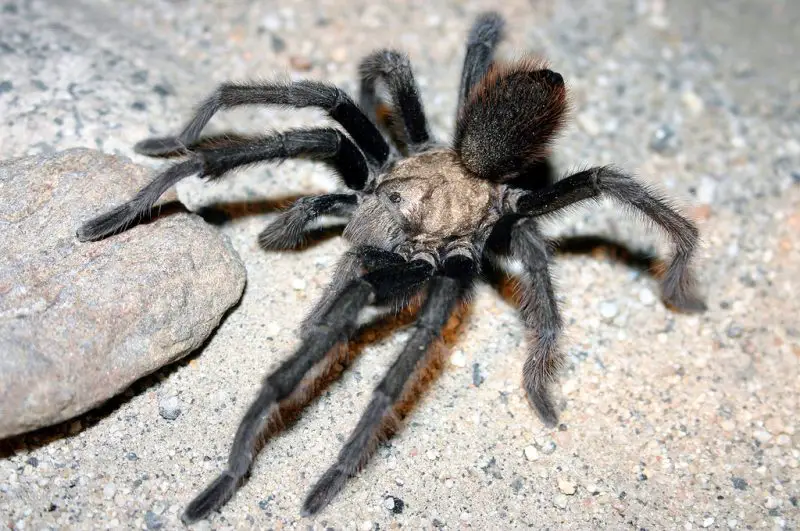
The California Ebony Tarantula is one of the largest and most iconic tarantulas found in California, known for its deep, glossy coloration and imposing size. Adult females can live up to 25 years, while males typically survive 8–12 years, reaching maturity later in life. Their leg span can measure around 5 inches, and their bodies are stout, muscular, and covered in dense hairs. They move in a deliberate, almost cautious manner, which, combined with their dark hue, makes them appear even more formidable in the wild.
Identification is relatively easy thanks to their uniform ebony-black to very dark brown coloration that covers both the cephalothorax and abdomen. The legs are thick and robust, with noticeable femurs that appear almost cylindrical. The hair on their body has a subtle sheen under sunlight, and males often appear slightly lighter and slimmer once they reach maturity.
These tarantulas are nocturnal ambush predators, patiently waiting at the entrance of their burrows for unsuspecting prey. Their diet consists of beetles, crickets, grasshoppers, and occasionally small vertebrates such as lizards and frogs. Most of their lives are spent underground, in silk-lined burrows that they expand and maintain over many years. Females rarely wander, while males leave their burrows during autumn to search for a mate, often traveling long distances across open terrain.
A fun fact about this species is that, despite their intimidating size, they pose little threat to humans. Their venom is mild, causing only temporary pain and swelling if a bite occurs. They play an important role in California’s ecosystems by controlling insect populations. Sightings often increase in September and October when mature males become more active, sometimes seen in suburban gardens or crossing hiking trails.
Desert Tarantula (Aphonopelma iodius)

The Desert Tarantula is a hardy species perfectly adapted to the extreme conditions of California’s arid environments. Females can live over 20 years, while males usually live for less than a decade. With a leg span of about 4 to 5 inches, they are moderately large, but their adaptations to desert life make them particularly resilient. They construct deep burrows that help regulate temperature and retain humidity, which are vital for survival in hot, dry regions.
In terms of identification, this tarantula displays colors ranging from light sandy brown to dusty tan, often with slightly darker legs. The overall coloration blends seamlessly with the desert soil, providing excellent camouflage from predators. Some individuals show faint striping on the femurs, and males tend to appear lighter in weight and more agile than females. Their bodies are covered in short, dense hairs that help them sense vibrations from potential prey or threats.
Their diet is composed of insects such as grasshoppers, beetles, and crickets, along with the occasional small reptile or amphibian. They are nocturnal hunters, emerging only after sunset to patrol their hunting grounds. During the late summer and early autumn mating season, males leave their burrows to roam the desert in search of receptive females, following pheromone cues left on the ground.
An interesting fact about the Desert Tarantula is its behavior of sealing its burrow entrance with silk and soil during the hottest parts of the day or during prolonged dry spells. This “door” acts as insulation, keeping the interior cool and moist. In California, they are especially common in areas like Joshua Tree National Park, Anza-Borrego Desert State Park, and the Mojave National Preserve.
San Diego Ebony Tarantula (Aphonopelma steindachneri)

The San Diego Ebony Tarantula is a medium-to-large species native to Southern California, particularly in the coastal desert and chaparral habitats of San Diego and surrounding counties. Adult females can live for more than 20 years, with a leg span reaching up to 5 inches. They are strong diggers, creating burrows in loose, sandy soils or beneath rocks and shrubs, which provide both shelter and camouflage.
They are generally black or deep brown, sometimes with a slight bronze or coppery sheen on the cephalothorax. Their hairs are fine and dense, giving them a velvety appearance. Males are more slender than females and become more active during mating season, while females remain reclusive, emerging only when hunting or during mild weather conditions.
Their diet primarily consists of insects such as crickets, beetles, and moths, but they will also take small invertebrates and other spiders if the opportunity arises. They are sit-and-wait predators, relying on quick bursts of speed to capture prey at the entrance of their burrows.
A fascinating behavior of this species is the “drumming” of the male during courtship. Males will use their front legs to tap rhythmically on the ground near a female’s burrow, signaling their presence and intentions. This subtle sound can travel through the soil, allowing the female to detect it without direct sight. In California, they are sometimes spotted crossing hiking paths at dusk, especially after warm days in late summer and early autumn.
Johnny Cash Tarantula (Aphonopelma johnnycashi)
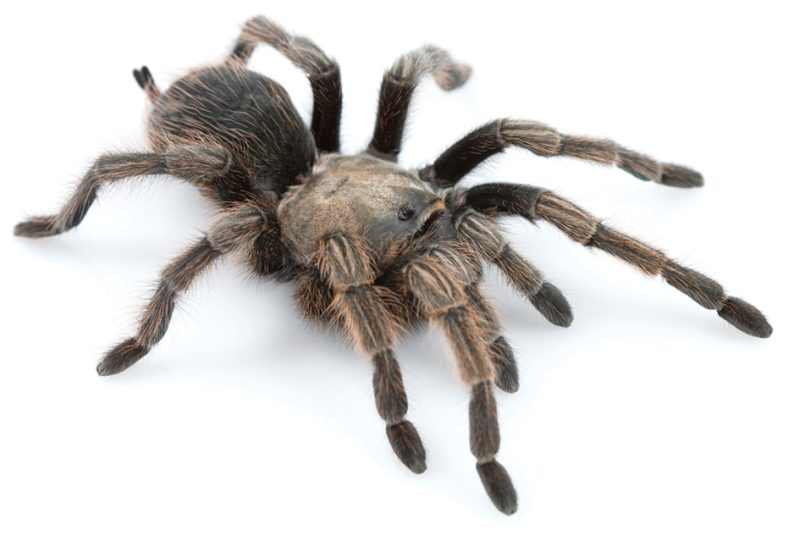
The Johnny Cash Tarantula is one of California’s more recently described species, discovered near Folsom Prison and named after the legendary “Man in Black.” Adult males are strikingly jet black, while females tend to be a dark, chocolate-brown. They are large spiders, with a leg span ranging from 5 to 6 inches, and have a robust body shape typical of the genus.
Their coloration is their most distinguishing feature, especially in males, whose deep black setae create a glossy, almost polished appearance. Females, though slightly lighter, have a similar dense hair coverage that aids in camouflage among leaf litter and soil. Their strong legs are well-suited for both digging burrows and tackling struggling prey.
They feed on a variety of insects such as beetles, grasshoppers, and moths, and occasionally consume other small animals like lizards or juvenile snakes. Like most tarantulas, they rely on stealth and sudden lunges rather than prolonged chases to capture their prey. Males wander widely during autumn, searching for mates by following chemical trails.
A unique fact about this species is its namesake. The name johnnycashi honors Johnny Cash not only for his black clothing but also because the type specimen was found near the prison made famous in his music. This naming has made the species a point of interest among both arachnologists and pop culture enthusiasts. In California, they are most often seen in the Sierra Nevada foothills and Central Valley grasslands.
Mojave Dwarf Tarantula (Aphonopelma mojave)
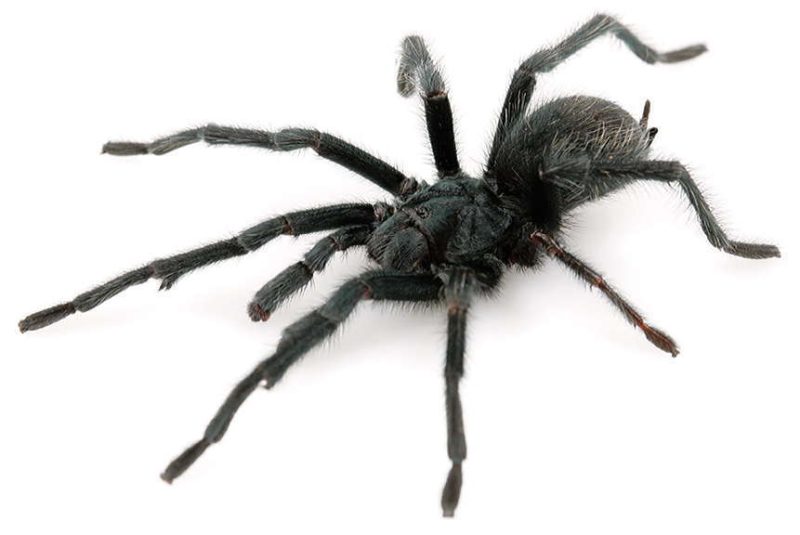
The Mojave Dwarf Tarantula is one of the smallest members of its genus in California, with adults reaching only about 2 inches in leg span. Despite their modest size, they are perfectly adapted to life in the Mojave Desert, where temperatures can fluctuate drastically between day and night. Their small size allows them to hide in narrow crevices and shallow burrows, which helps them avoid predators and extreme weather.
Their coloration is typically sandy beige to light brown, blending almost perfectly with the desert substrate. This natural camouflage, combined with their fine hair coverage, makes them extremely difficult to spot unless they are moving. Males are slightly more slender and lighter in tone than females.
They feed primarily on small insects, including ants, beetles, and tiny grasshoppers. Because they are more vulnerable to predators than larger tarantulas, they rarely venture far from their burrows. When threatened, they retreat quickly and may use a plug of silk and soil to block the entrance.
One fascinating trait of this species is its ability to endure long periods without food by slowing its metabolism significantly. This survival strategy is crucial in the desert, where prey may be scarce. In California, sightings of the Mojave Dwarf Tarantula are rare and usually occur in late summer during the brief mating season when males are on the move.
Joshua Tree Tarantula (Aphonopelma joshua)
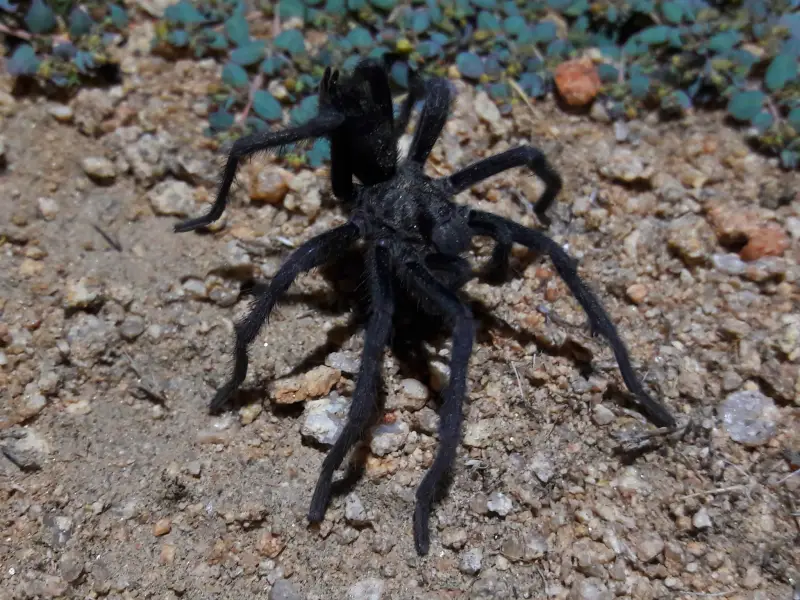
The Joshua Tree Tarantula is a desert-dwelling species found primarily in and around Joshua Tree National Park, thriving in the unique ecosystem where the Mojave and Colorado deserts meet. Females are medium to large in size, with a leg span of 4.5 to 5 inches, and can live more than 20 years, while males live only a few years after reaching maturity. They spend most of their time in silk-lined burrows dug into sandy or gravelly soil, often near the base of plants or rocks for stability.
Their coloration typically blends with the local desert environment—light brown to tan with slightly darker legs and abdomen. This earth-toned camouflage helps them avoid predators such as birds and small mammals. Males are more slender and lighter in weight, especially during mating season in late summer and early fall, when they wander across open desert areas.
Their diet is dominated by insects such as crickets, beetles, and grasshoppers, though they may also take small lizards or other arthropods. Hunting is primarily nocturnal, with the tarantula waiting just inside its burrow for vibrations that signal passing prey.
A fun fact is that this species is particularly adapted to the Joshua Tree’s harsh seasonal changes, tolerating high summer heat and cold winter nights by retreating deep underground. Because of their limited range, they are one of California’s less frequently observed tarantulas.
Lucerne Valley Tarantula (Aphonopelma icenoglei)
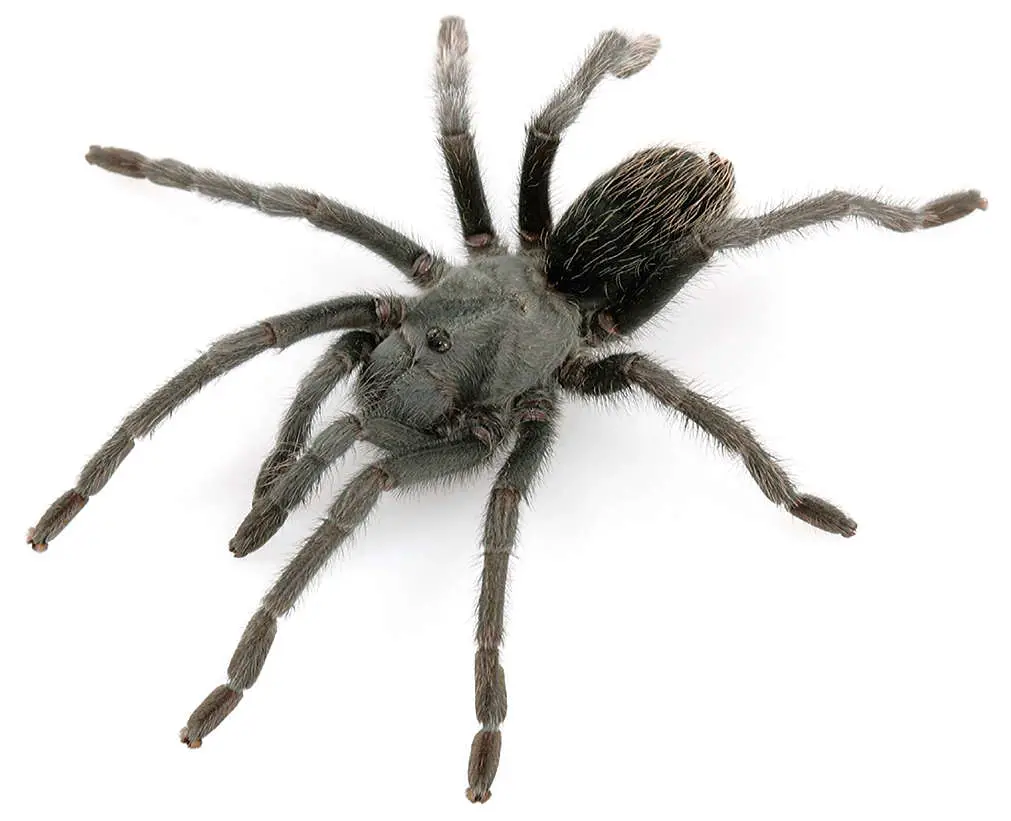
The Lucerne Valley Tarantula inhabits the high desert regions of San Bernardino County, including areas around Lucerne Valley and Victorville. It is a medium-sized species, with a leg span of about 4 inches. Females are sturdy and robust, while males appear leaner, especially during their seasonal search for mates.
Their coloration is often a dusty brown or sandy beige, matching the arid soils of their habitat. Fine, short hairs cover the body, and under close observation, a subtle golden or copper hue may be visible under sunlight. This coloration, combined with their tendency to remain near burrow entrances, makes them well-camouflaged in desert terrain.
They feed on small insects, particularly beetles, grasshoppers, and occasional small arachnids. They are patient predators, relying on stealth and sudden lunges rather than long pursuits. Activity peaks at night when temperatures drop to more tolerable levels.
An interesting fact about Aphonopelma icenoglei is that it was formally described only in recent years, highlighting how much of California’s desert arachnid fauna remains understudied. Its range overlaps slightly with Aphonopelma mojave, but the two species are distinct in both size and coloration.
Paso Robles Rusty Red Tarantula (Aphonopelma chamberlini)
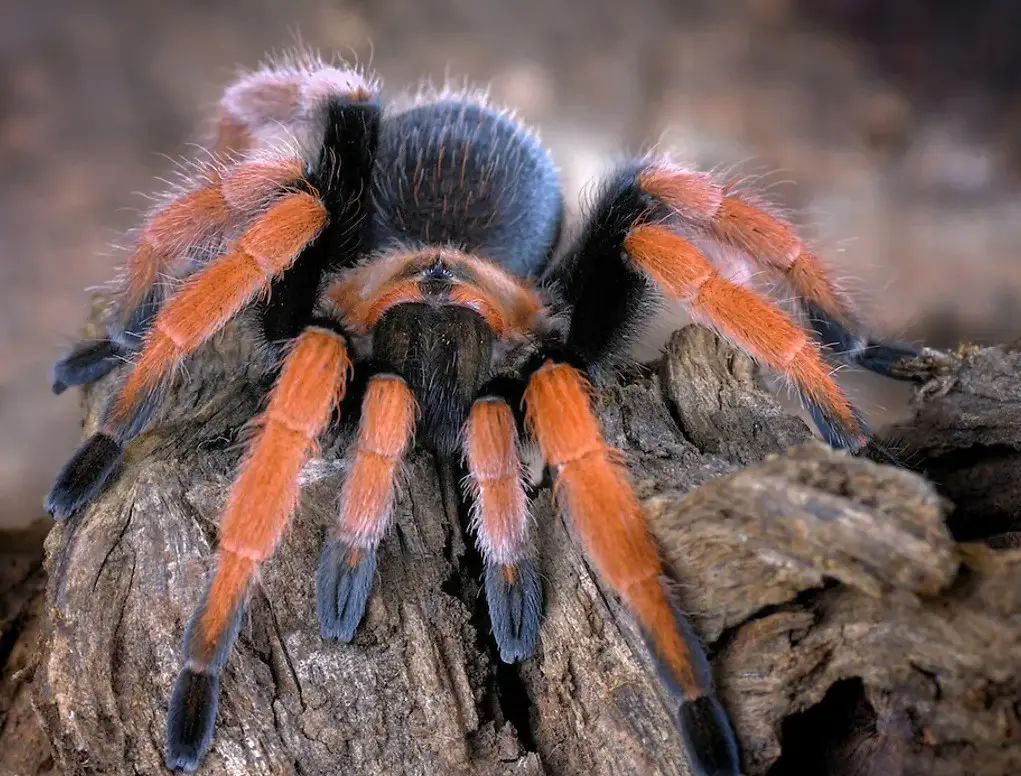
The Paso Robles Rusty Red Tarantula is native to the central coast ranges of California, especially around Paso Robles. It is a medium to large species with a leg span of 4.5 to 5 inches, and females can live over two decades. Burrows are typically found in grassland soils or beneath rocks, where humidity remains slightly higher than in surrounding open areas.
Its most striking feature is its coloration—reddish-brown to rusty orange hairs on the abdomen and legs, contrasting with a darker cephalothorax. This warm tone is unusual among California tarantulas, making it one of the more visually distinctive species in the state.
Its diet is varied, including crickets, beetles, caterpillars, and occasionally small vertebrates. Like other tarantulas, it waits near its burrow entrance at night, ambushing prey with a sudden pounce. Males emerge in the fall to roam in search of females, sometimes covering considerable distances.
A notable fact is that Aphonopelma chamberlini has been the subject of taxonomic debate, with some experts suggesting it may be a regional variant of Aphonopelma iodius. However, its coloration and restricted range support its recognition as a distinct species by many arachnologists.
False Tarantulas (Calisoga spp.)
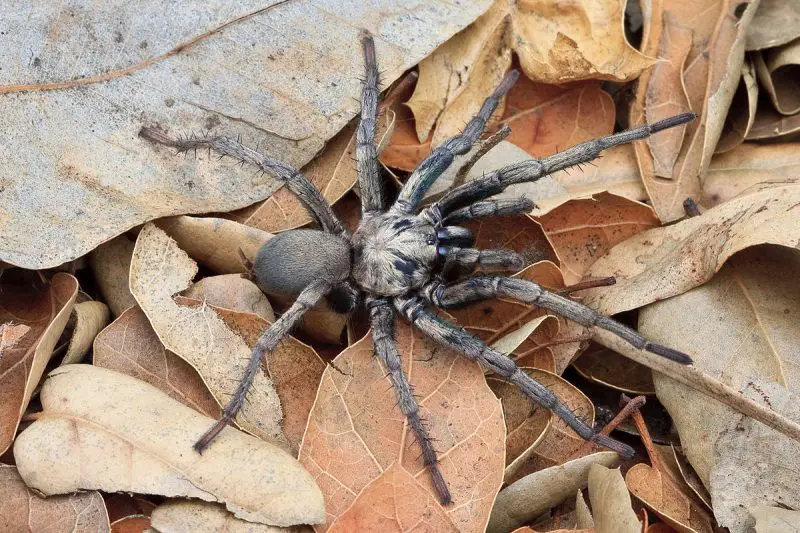
False Tarantulas of the genus Calisoga are not true tarantulas but are often mistaken for them due to their large size and hairy appearance. They are found in various parts of California, including foothill regions and scrubland habitats. Adults typically have a leg span of 2 to 3 inches and a more elongated body than true tarantulas.
Their coloration is usually dark brown to black, with a somewhat shinier cephalothorax and less dense hair coverage on the legs. They tend to have longer, thinner legs compared to Aphonopelma, and their movement is quicker and more agile.
False Tarantulas feed on insects, spiders, and other small arthropods. They are active hunters rather than ambush predators, roaming at night in search of prey instead of waiting in burrows.
A fun fact is that despite their resemblance, Calisoga species are more closely related to trapdoor spiders than to tarantulas. Their bite can be more painful than that of most Aphonopelma, though it is still not dangerous to humans.
Desert Blonde Tarantula (Aphonopelma chalcodes)
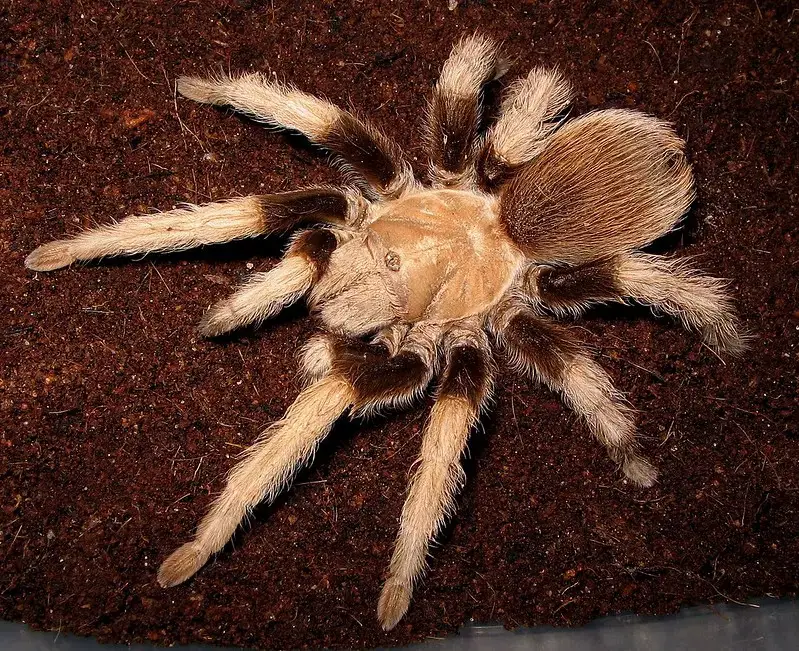
The Desert Blonde Tarantula is more common in Arizona but has a limited range in southeastern California near the Colorado River. Females can grow to a leg span of 5 inches and live over 20 years, while males live only a few years. Their burrows are often found in sandy soils near desert washes and scrubland.
Their coloration is distinctive, with a pale blonde cephalothorax, dark brown abdomen, and light tan legs. This contrast gives them a striking appearance compared to the more uniformly colored California tarantulas.
Their diet consists mostly of insects such as crickets, beetles, and grasshoppers, but they may also capture small vertebrates if the opportunity arises. They are primarily nocturnal and remain hidden in their burrows during the heat of the day.
A unique fact is that males of this species are known for their long-distance wanderings during the mating season, sometimes traveling several miles. Because of their beauty, they are also among the most popular tarantulas in the U.S. pet trade, though California populations are rarely collected.
Bay Area Blonde Tarantula (Aphonopelma smithi)
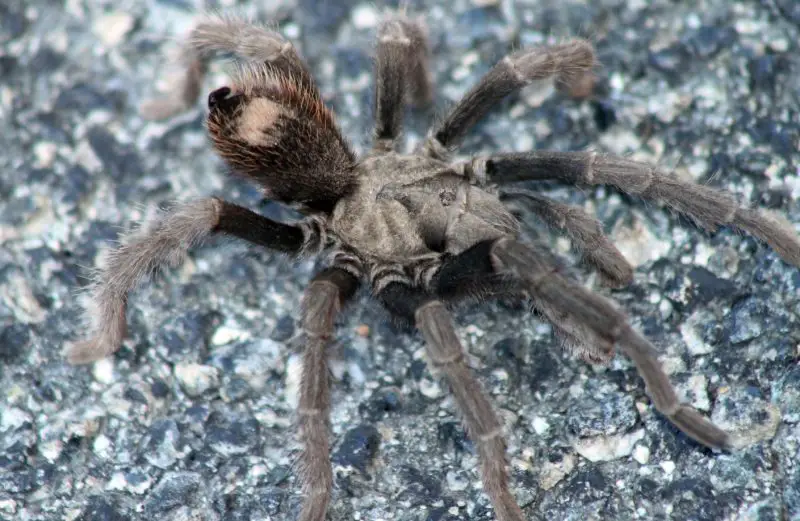
The Bay Area Blonde Tarantula is native to the coastal and inland valleys of Northern California, especially in the San Francisco Bay Area and surrounding foothills. Females can live over 20 years, with a leg span of about 4.5 to 5 inches, while males live much shorter lives. They are most often encountered during the fall mating season, when mature males wander far from their burrows in search of females.
Their most distinctive feature is the blonde to light tan coloration on the cephalothorax, which contrasts with a darker abdomen and legs. This color pattern helps them blend into the golden-brown grasses and dry soil common in their habitat. Fine hairs cover the body, and the abdomen may show faint striping under certain light conditions.
The Bay Area Blonde feeds primarily on insects such as crickets, beetles, and grasshoppers, though they will also consume other spiders and small invertebrates. They typically wait at the entrance of their burrows at night, pouncing when prey comes within range.
A fun fact is that this species has one of the most limited ranges among California tarantulas, with populations concentrated in specific microhabitats. Conservationists have raised concerns about habitat loss due to urban expansion, making this tarantula less common than it once was.
California Trapdoor Spider (Bothriocyrtum californicum) – not a true tarantula
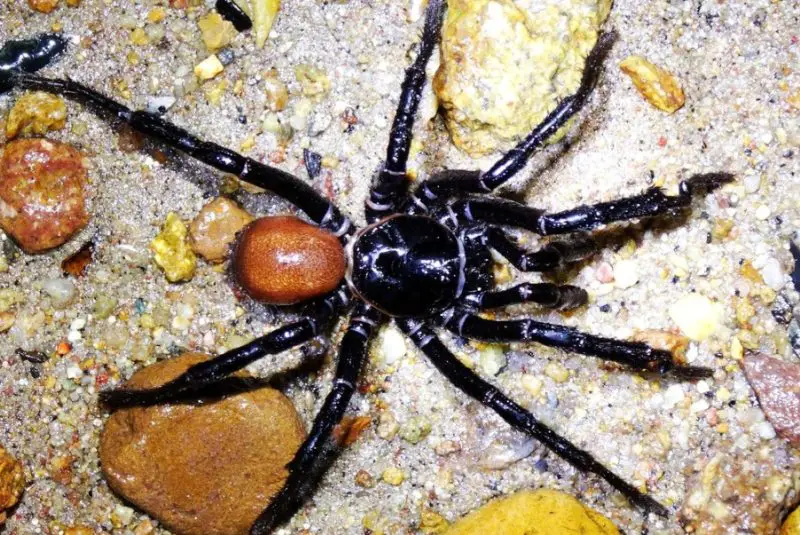
The California Trapdoor Spider is often mistaken for a tarantula because of its size and hairy body, but it belongs to a different family (Cyrtaucheniidae). Adults are smaller than most tarantulas, with a leg span of about 1.5 to 2 inches. They are found in chaparral, oak woodland, and desert margins across much of California.
Their coloration is usually dark brown to black, with a glossy cephalothorax and stockier build compared to most true tarantulas. They construct silk-lined burrows topped with a camouflaged “trapdoor” made of soil, plant matter, and silk. This door allows them to ambush prey while remaining almost invisible to predators.
They feed on ants, beetles, crickets, and other small arthropods. When prey brushes against silk trip lines outside the door, the spider lunges out, grabs the victim, and retreats to feed in safety.
A fascinating fact is that trapdoor spiders can live over 20 years in the wild without ever traveling more than a few feet from their original burrow. Their secretive nature means they are rarely seen except during heavy rains, when males leave their burrows to find mates.
California Parson Spider (Herpyllus ecclesiasticus) – not a true tarantula

The California Parson Spider is a fast-moving ground spider that is sometimes confused with small tarantulas because of its dark color and hairy legs. In reality, it belongs to the family Gnaphosidae and is much smaller, with a body length of about 0.4 to 0.6 inches. It is found throughout California in forests, grasslands, and even inside homes.
Its appearance is distinctive, with a velvety black cephalothorax and abdomen marked by a white or gray dorsal stripe, reminiscent of a clerical collar—hence the name “parson.” The legs are covered in fine hairs and are well-adapted for quick bursts of speed when chasing prey.
Unlike tarantulas, parson spiders do not use burrows. They roam actively at night in search of insects and other small arthropods, often hunting along the ground or low vegetation. They rely on speed and agility rather than ambush tactics.
A fun fact is that while their bite can be painful, it is harmless to humans, and they play an important role in controlling household pest insects. Because they are frequently spotted indoors during cooler months, they are one of the more familiar “false tarantulas” to California residents.
FAQs about Tarantulas in California
What is the most common tarantula species in California?
The most frequently encountered species is the Desert Tarantula (Aphonopelma iodius), which is widespread across much of the state, particularly in arid and semi-arid regions.
Are California tarantulas dangerous to humans?
No. While their bite can be painful and cause mild swelling, California tarantulas are not considered medically dangerous to humans. They are generally shy and will retreat rather than bite.
How big do California tarantulas get?
Most female tarantulas in California reach a leg span of 4.5 to 5 inches, while males are slightly smaller and more slender. Some individuals can reach 6 inches.
What do California tarantulas eat?
Their diet includes crickets, beetles, grasshoppers, moths, and occasionally small vertebrates like lizards or frogs. They are opportunistic nocturnal hunters.
Where can I find tarantulas in California?
They live in deserts, grasslands, oak woodlands, and chaparral habitats. Common hotspots include Joshua Tree National Park, the Mojave Desert, and foothill regions.
When is the best time to see them?
The best time is during the late summer and fall (August–October), when mature males leave their burrows to search for females, often crossing roads and open terrain.
What is a “false tarantula”?
A “false tarantula” refers to large, hairy spiders that resemble tarantulas but belong to different families. Examples in California include Calisoga species (California False Tarantulas) and the California Trapdoor Spider (Bothriocyrtum californicum).
How long do California tarantulas live?
Females can live over 20 years, while males typically live only a few years after reaching sexual maturity.
Can I keep a California tarantula as a pet?
It is legal in some areas, but collection from the wild may be regulated. Captive breeding is encouraged over taking wild specimens to protect natural populations.






